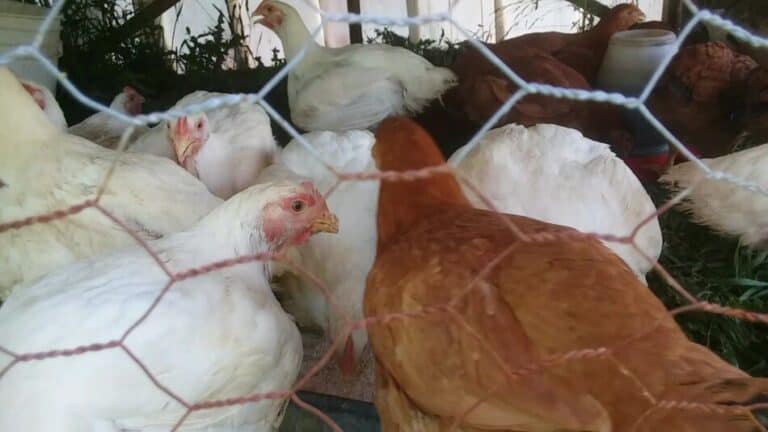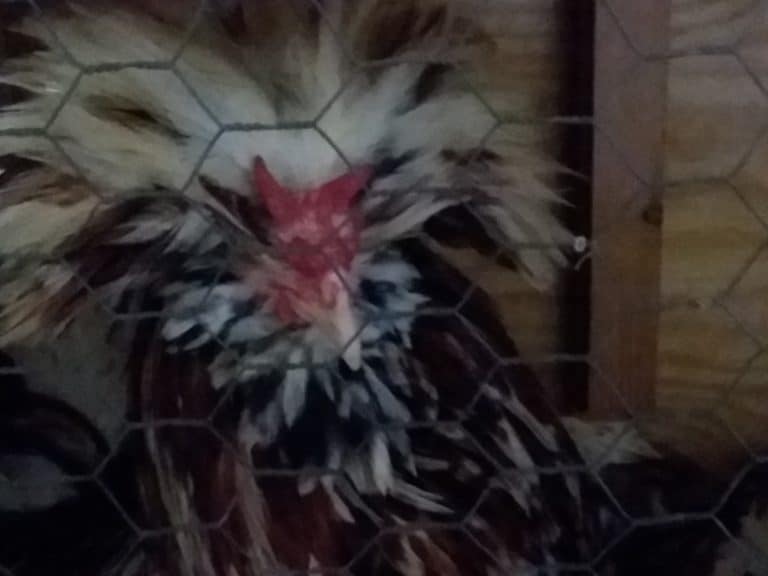20 Of The Calmest Chicken Breeds: Family Friendly Choices
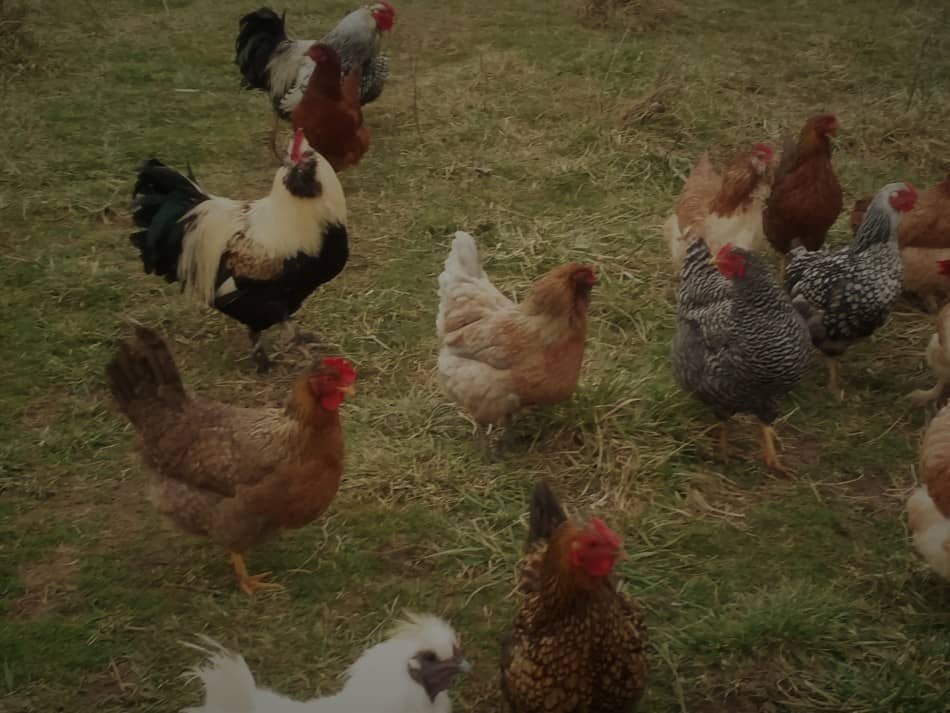
Interested in getting some chickens for the backyard? Here is a list of calm chicken breeds that would be great for you and your family!
Calm chicken breeds list
- Jersey Giant
- Brahma
- Cochin
- Cornish
- Orpington
- Plymouth Rock
- Dorking
- Sussex
- Houdan
- Crevecoeur
- Australorp
- Rhode Island Red
- Maran
- Wyandotte
- Faverolles
- Barnevelders
- Dominique
- Welsummer
- Polish
- Sultan
Is Raising Chickens For Eggs Worth It? is an article I wrote to help you work up a budget to determine the costs of having egg layers in your area.
Look over this table to help you sort out which chicken will suit you best then read below for a more complete breed description.
| Breed | Eggs per week | Known for |
| Jersey Giant | 3-4 large size, brown | large body size |
| Brahma | 3-4 medium size, brown | winter hardy |
| Cochin | 3-4 medium size, light brown | low body carriage |
| Cornish | 3-4 large size, brown | meaty build (surprisingly heavy for size) |
| Orpington | 3-4 large size, brown | good grazers |
| Plymouth Rock | 3-4 large size, brown | hardy foragers |
| Dorking | 3-4 medium to large, white | wonderful setters and moms |
| Sussex | 3-4 large size, brown | hardy foragers |
| Houdan | 2-3 medium size, white | rare breed |
| Crevecoeur | 2-3 medium size, white | rare breed |
| Australorp | 5-6 large size, brown | productive (most eggs of any breed listed here) |
| Rhode Island Red | 5+ large size, brown | hardy forager |
| Maran | 3-4 large size, dark brown | hardy forager |
| Wyandotte | 4-5 medium to large size, brown | versatility and color/pattern choices |
| Faverolles | 4-5 small to medium size, light brown | bearded face and feet |
| Barnevelder | 3-5 medium to large, dark brown | hardy forager |
| Dominique | 3-4 medium size, brown | heat and cold tolerant |
| Welsummer | 3-4 medium size, dark brown speckled | great forager |
| Polish | 2-3 small to medium size, white | fun look |
| Sultan | 2-3 small to medium size, white | rare breed, great broody hen |
Please note that egg production is based on the layers getting laying mash, a special high calcium feed. Without the laying mash, production will be poor.
To get the best out of your birds, feed them according to their needs, which means laying mash (no worries, it should be easy to find) once they get close to laying age.
Jersey Giant chickens are 13+ pounds
- 3-4 eggs per week
- slow to mature
The Jersey Giant is an American breed originating in New Jersey around the year 1880.
Jersey Giant is a large, very large chicken with roosters weighing 13 pounds normally with caponized roosters (capon means neutered) getting upwards of 20 pounds.
Everything about this bird is long and broad giving ample space on the skeletal frame to put on weight.
At our county fair an exhibitor always brings a pair of these beautiful chickens to show. They really are an impressive sight. These birds even have big tail feathers!
Appearance wise Jersey Giants have a single comb (the classic rooster comb shape) and most commonly black plumage.
White Jersey Giants were developed mid century and Blue laced most recently.
Hens are broody and will lay 3-4 large sized brown eggs per week. Jersey Giants tend to be slower to mature than other breeds simply because they are growing so much bigger.
These chickens are docile and can become very tame. Because of their large size and weight, Jersey Giants might be too much to handle for kids without adult help.
What Is Laying Mash? will go over what this specific feed is, the reasons why your flock would need a special diet like this and times when they do not.
Brahma chickens have a calm demeanor
- 3-4 medium sized brown eggs per week
- popular backyard bird
The Brahma chicken is originally from India. It is a large friendly bird that looks stocky -shorter neck and broad body.
We have had some of these in the past and I always like their calm demeanor, especially when compared to some of the more excitable breeds.
In the looks department they have feathered legs and feet, a pea comb (a small comb that is close to the head so it is good for areas that get cold) and multiple color and pattern choices with something for everyone.
The head and tail are a contrasting color to the body with black head, neck and tail feathers being common.
The more usual Brahma colors include buff, dark, and light. Unusual Brahma colors and patterns include penciled (dark edge outlining the feather) silver, penciled partridge, penciled blue, and the columbian varieties.
A Brahma hen will lay 3-4 eggs per week once she gets to maturity which will be six to seven months old. Hens will lay a medium sized egg well into the winter as they are very cold hardy.
These gals make nice pets, are easy to handle, get along with other birds and are relatively quiet-all qualities that make the Brahma a popular backyard chicken.
How Much Space Do Chickens Need? will show you how to calculate up the area you need to keep your flock happy!
Cochin chickens are great pets
- 3-4 eggs per week
- wide bird that always looks like a show chicken
The Cochin breed of chickens is from China. A larger breed of chicken that has a fluffy low set look.
These chickens are big and wide. They have feathered feet and a single comb. Since they are so pretty and naturally friendly they make good pets and show birds alike.
Color options are black, blue, white, buff, silver laced, partridge, and cuckoo which is black and white striped multiple times across each feather.
Cochins are not flyers so they can not get up off of wet ground or get away from predators but they will be very easy to fence.
Hens will lay a medium light brown egg 3-4 times per week.
Cornish are very wide bodied chickens
- 2-3 eggs per week
- good foragers
- naturally built as a very meaty chicken
The Cornish chicken is from the United Kingdom, specifically the counties of Devon and Cornwall.
These birds were called Indian Game Fowl or Indian Fighters since they were created to use as fighting cocks.
The Cornish were too slow to be fighters being that they are naturally a placid, easy going bird but were and still are perfect to be used as table birds.
Cornish are one of the foundation breeds for the modern broiler. They are an obvious meat bird choice because of it’s extremely wide, heavy build, fast growth and calm nature.
Cornish roosters weigh 9-10 pounds and seem to waddle more than walk-these guys are broad. Hens lay 2-3 light brown eggs per week, are good foragers and like to get out and peck for food. They are not broody.
Color choices are just a few with double laced being the most popular. The other colors of Cornish are red white double laced and white and red white laced.
6 Tips To Naturally Fatten Up Your Chickens will give you tips on how to keep your birds in top form!
Orpington’s are a beautiful backyard chicken
- beautiful and very popular chicken
- 3-4 large brown eggs per week
- good moms
The Orpington chicken is a docile and affectionate bird originating in the village of Orpington, England.
Orpingtons have a single comb and look low to the ground because of their full body and plentiful feathering.
These are big, heavy birds that are very popular world wide because of their ease of training and wide selection of color variations.
Orpington roosters are large weighing up to 9 pounds. These chickens are good grazers and easy to pen because being heavy means they are not likely to pop up and over your fence.
Orpington hens are wonderful layers producing 3-4 large brown eggs per week. She is broody and a good, reliable mom when the chicks hatch.
The most popular color for Orpingtons is buff. My father in law had a flock of these in his yard. The buffs were lovely to see and provided eggs for their house with plenty of extra dozens for neighbors and friends.
Other Orpington colors include black, blue, barred, multiple penciled partridge and my favorite buff black laced-a beautiful bird! These are just a few of the wide range of colors for Orpingtons, there are tons of choices.
Plymouth Rock is a classic backyard chicken
- great foragers
- wonderful choice for beginners
- 3-4 large brown eggs per week
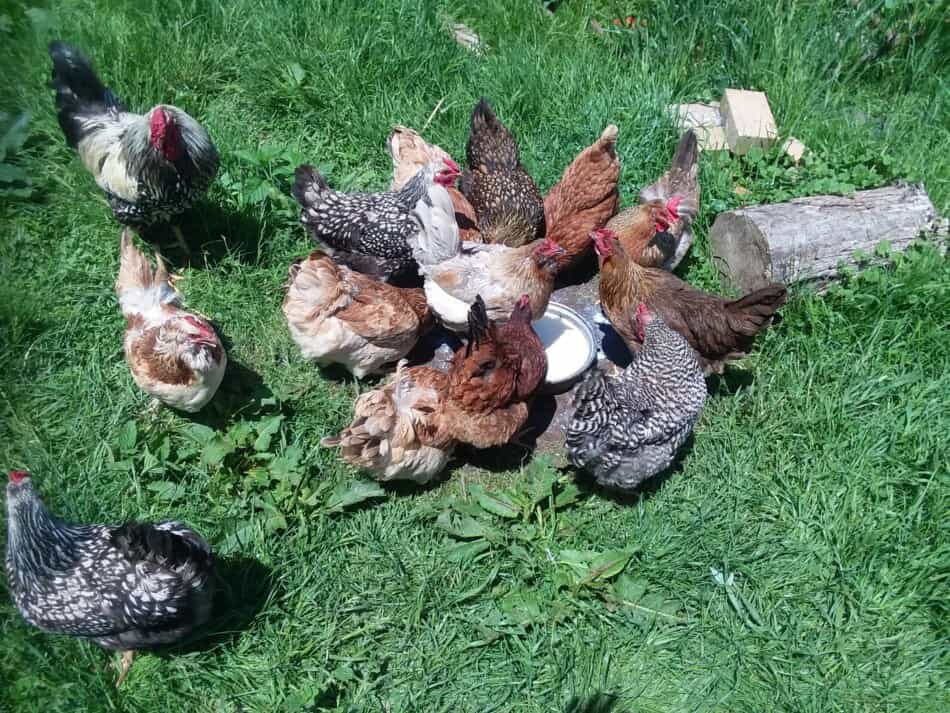
The Plymouth Rock is an American breed recognized in 1874.
Then it was called Barred Plymouth Rock since all of the original birds were the barred (having small alternating white and black stripes across each feather) pattern.
These are large chickens with roosters weighing 10 pounds. Rocks are one of the most popular breeds of chickens in the U.S.
Rocks are a dual purpose breed meaning they are good for meat and egg production.
Hens will lay 3-4 large brown eggs per week and are good foragers. These are friendly, calm birds that would make a great choice for beginners.
We have a small flock of the barred variety now.
Plymouth Rocks are good at laying eggs through the winter and ranging out to find bugs, weeds and grass shoots in the summer but will also readily come back to the coop when you take them some feed.
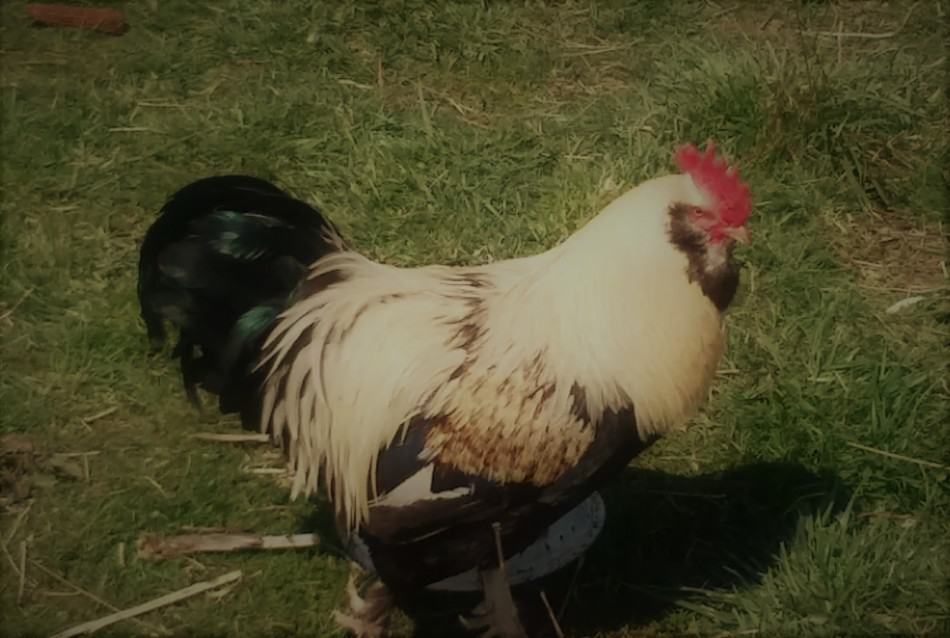
Dorking is the foundation breed chicken
- 3-4 medium large white eggs per week
- a foundation breed used to develop many other breeds
The Dorking is a very old chicken breed from the United Kingdom. These chickens are a heavy, table breed with tremendous flavor.
Dorking was so well regarded for it’s eating qualities it was consistently used as one of the base breeds to create multiple other table breeds including Faverolles and Houdans (to name just a few).
The Dorking is a heavy chicken with roosters weighing 11 pounds and hens weighing 9 pounds.
Hens are wonderful setters and attentive moms. She will also welcome chicks hatched by other hens-not all hens will take care of chicks that are not hers.
This breed has a very low stance due to having a deep, long body and short legs. Dorkings have a large single comb and a fifth toe. Other breeds that also have a fifth to have Dorking breeding somewhere in their making.
The most common Dorking color is silver partridge. This breed also comes in partridge, white, red and cuckoo.
Dorkings are friendly, calm chickens that need some room to run around to keep in good shape. Hens will 3-4 medium large white eggs per week even through the winter.
Sussex chickens are becoming popular
- quickly becoming a top backyard chicken choice
- 3-4 large brown eggs per week
- will raise chicks
The Sussex chicken is calm and friendly. They are a strong, hardy chicken that likes to forage for some of their own food.
Sussex hens lay 3-4 large brown eggs per week, even continuing to lay through the winter.
She will be broody and a wonderful attentive mom if you decide to let her accumulate a clutch of eggs, set and raise her chicks.
Sussex chickens are from the United Kingdom where they remain steadily popular. These chickens are a heavier built bird with white legs and a medium sized singe comb.
Sussex chickens come in red porcelain (also called speckled), columbian, buff columbian, red columbian, fawn, brown, white, cuckoo and grayish silver. The color commonly available is red porcelain.
Houdan chickens are known for flavor
- famous for great flavor
- listed as “threatened” on The Livestock Conservancy rare breeds list
The Houdan chicken was developed in the Normandy region of France in order to have a fast growing, heavy chicken for the Paris restaurant market.
Houdans were created from the Crevecoeur (next on this list) being crossed with local breeds then crossing those chickens again this time with Dorkings to make them even meatier.
Like it’s ancestors the Houdan has a crest, a beard and a fifth toe. The main color of Houdan is black mottled but white and lavender are also possible.
Black mottled means this chicken has a black body and crest with small blotchy white spots.
Houdans are calm, like all table breeds, and fast growers with roosters weighing 8 pounds and hens weighing 6.5 pounds.
Houdans are a “Label Rouge” breed which is a French certification meaning they on the best of the best list for taste and eating quality.
Houdan hens are productive layers when well cared for. They tend to be broody but because of their weight can easily crush eggs.
It is best to have another hen brood and hatch Houdan chicks for you.
Crevecoeur is a crested rare chicken breed
- listed as “critical” on The Livestock Conservancy rare breeds list
- known for easy going temperament
- unique looks
The Crevecoeur chicken is another wonderful breed from France, this time the Normandy region.
These are crested birds that also have a beard and a fifth toe. Crevecoeurs were originally a table breed so they are meaty birds developed for its high proportion of fine, white meat.
Calm chickens grow faster so Crevecoeurs breeders have always kept an easy going temperament as a breed trait.
These chickens are calm enough they can stay in the pen but like other chickens enjoy getting out into the yard for some exercise and free time to peck around.
Hens will produce a large white egg and are occasionally broody.
Color choices are easy with this breed -black if you want the original with blue and white options if you are interested in the more recent color variation.
The Crevecoeur has a very low numbers in the U.S. so it is on the Conservation Priority List at The Livestock Conservancy.
Crevecoeurs are a breed that could use some help regaining popularity. Good growers with a peaceful temperament-sounds like a great family friendly choice.
Australorp is an egg laying machine
- highly productive purebred egg layer
- 5-6 large brown eggs per week
- friendly birds with beautiful shiny black/green feathers
The Australorp is from Australia developed in the 1920’s. These chickens were bred as a dual purpose breed so they have good meat and egg laying qualities.
Actually, the Australorp is the highest egg producer on this list. Hens are non broody and start producing early at five months of age. She will lay 5-6 large brown eggs per week.
These birds are friendly and love to roam about your yard. Australorps are most frequently black with a green sheen to the feathers. They also come in white and laced blue.
There are a lot of great birds on this list, but Australorps are a favorite for me. They are the complete package and I am constantly surprised that they are not more popular!
Rhode Island Red is an American breed
- classic barnyard/backyard chicken
- lays 5+ eggs per week
- good foragers
The Rhode Island Red chicken originated in the U.S. over one hundred years ago. It was started as a utility breed meaning a meat, eggs, and easy care chicken in the State of Rhode Island.
Rhode Island Reds are wonderful layers of 5 or more large brown eggs per week.
High egg production, tied with Austrolorp for the most productive calm layer, combined hardiness make Rhode Island Red a popular choice for homesteading chicken enthusiasts.
I have just one of these hens right now, she is an egg laying machine!
These gals like to forage which is great for you because when chickens eat bugs and grass you benefit from the much healthier orange egg yolks.
The more orange the yolk, as opposed to pale yellow like store eggs, the more the hen had access to a variety of foods so she got more nutrition that she can pass on to the eggs for you or better hatching healthier chicks.
A word of caution here-the roosters can be aggressive in this breed. If you just want eggs, no problem, hens don’t need a rooster around to lay eggs.
If you want fertile eggs then by all means keep a rooster just keep your eye on him and get rid of him if he starts acting differently than the hens-a sure sign he’s thinking to push you around.
As far as color, Rhode Island Reds only come in red-probably as you expected.
What you might not have expected is that outside of the U.S. Rhode Island chickens come in two colors white or red.
In the U.S. the Rhode Island White is considered to be a completely separate breed from Rhode Island Red.
Marans are gentle and lay dark brown eggs
- lay 3-4 dark brown eggs per week
- great, family friendly personality
- come in a variety of colors
The Marans is a breed originating in the village of Marans, France. Marans are friendly, gentle birds that are available in multiple colors and lay very dark brown eggs.
The Marans hen is a good layer producing 3-4 large sized dark brown eggs. These are strong, hardy birds that are seldom broody.
These gals like to forage and are heavy enough that flying out of your pen is unlikely.
Marans come in a variety of colors including brassy black, cuckoo, golden cuckoo, black, silver cuckoo, white, and columbian.
Interestingly enough, the brassy black coloring has a brass or copper colored sheen to the feathers. This is unusual because other black colored chickens breeds have a green sheen.
Wyandottes are a great all round chicken
- gentle, good sized birds
- heavier (more meaty) than they look
- lots of colors and patterns to choose from
- hardy and reliable producer
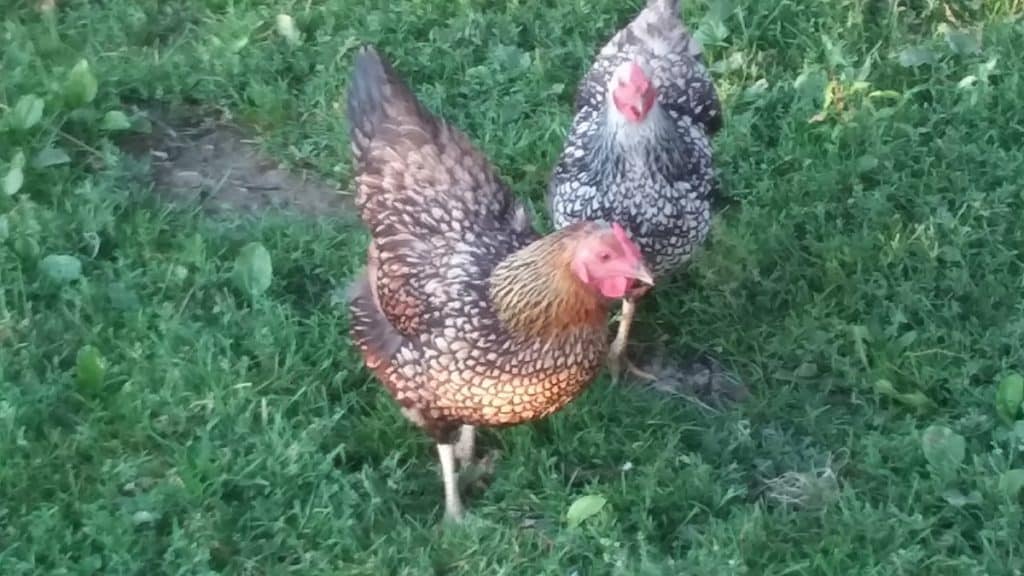
The Wyandotte chicken is another American breed started in the 1860’s.
These chickens are friendly and great with kids so they would be ideal for someone who just wants a few gentle and tame hens for the grandchildren (or yourself).
Wyandottes are good sized birds that will love to forage around your yard.
Wyandotte hens lay 4-5 medium to large sized brown eggs per week. Egg shell color can vary from lightly tinted to brown. She is broody and an excellent mom.
The original Wyandotte color is silver laced.
They also come in a huge variety of other colors including white, black, blue, blue laced, buff, red, barred, gold black laced, yellow black laced, silver black laced, golden blue laced, yellow white laced, columbian, buff columbian, buff columbian blue marked, cuckoo, triple laced partridge, triple laced blue partridge, triple laced penciled silver partridge, and black white mottled.
To me, Wyandottes are the perfect breed for anyone who wants production, great attitude, color choices and a wonderful stewing hen.
I always recommend Wyandottes to anyone with homesteading or in mind or who just wants a hardy, reliable chicken.
Faverolles are very friendly, gentle birds
- wonderful attitude
- interesting looks with a feathered face and legs and a 5th toe
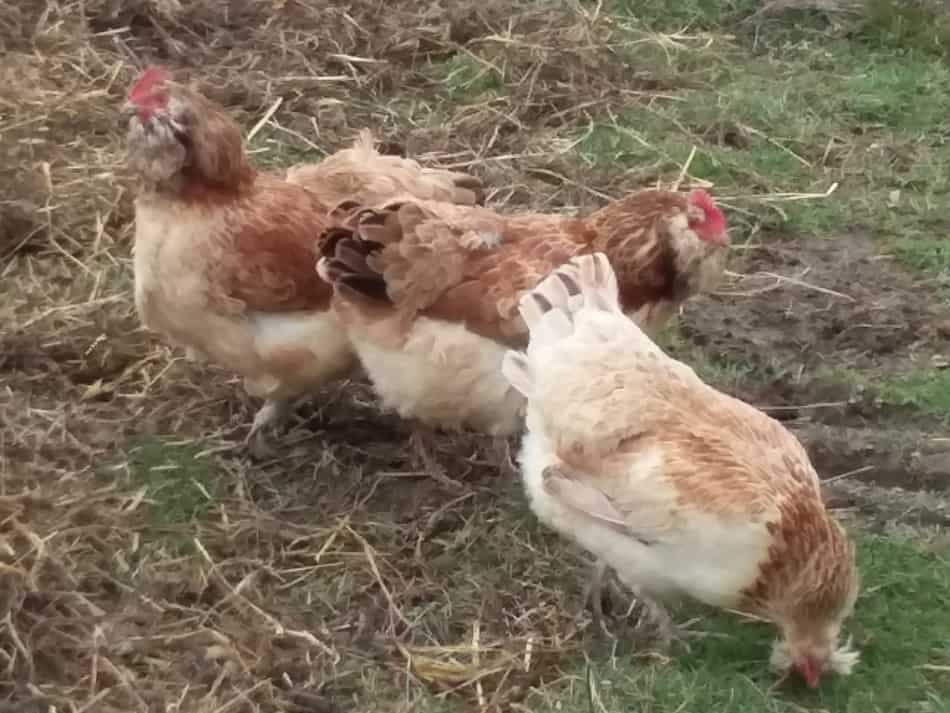
These are the chickens also pictured at the beginning of the article.
The Faverolles chicken was created over 100 years ago in order to fill the growing demand for table fowl-meaning people wanted a bigger bodied, meatier chicken for roasting.
Local chicken breeders crossed their existing flocks with Brahmas and Dorkings to get more size and meatiness.
Faverolles were developed in France in near the village of Faverolles, hence the breed name.
Faverolles are known for being very friendly, gentle chickens to raise making them a great choice of a chicken to have around kids.
Hens will lay 4-5 smaller sized light brown eggs throughout both the summer and winter. My Faverolles hens also are good setters, hatching out and raising 10+ chicks each time.
Faverolles have feathered feet, a fifth toe and a single comb. These birds are fast growers that will need a bit of exercise to keep in good shape.
Faverolles have three basic types: French, German and British.
All Faverolles chickens have deep, heavy, elongated bodies with the three types varying in how high the birds carry their tails.
The head of a Faverolle is memorable-it has a kind of crazy looking puffy beard that forms three clumps so the beard feathers stick out to the sides as well. Both roosters and hens have a puffy beard!
Originally the Faverolle was the salmon colored French type but now there are also cuckoo, white, black, blue and columbian varieties.
Interestingly enough, once mature the rooster has a very different color pattern than the hens almost making it look like they are from completely separate breeds.
Barnevelder is rising in popularity
- hearty, great forager
- 3-4 dark brown eggs per week
The Barnevelder chicken is from the Netherlands and is well known for being a calm, docile chicken that lays dark brown eggs.
These birds are a hearty chicken that will do well foraging around-they are also heavy enough to be unlikely to escape over your fence.
Barnevelders lay 3-4 large dark brown eggs per week.
As with all dark brown eggs the shell color will fade as the hen lays more eggs but will return to dark again her next laying cycle after she molts (sheds her feathers and grows new ones).
Common colors for these gals include black, white, double laced and blue double laced. The double laced is the most common Barnevelder color.
Dominique is an American original
- adaptable, broody hens
- 3-4 medium eggs per week
The Dominique is considered as America’s first chicken breed. It also was called Blue Spotted Hen, Old Grey Hen, and Dominiker.
Dominiques are barred chickens that were popular in the eastern states in 1820’s.
These are a medium sized bird that is gentle and calm making it easy to show. Roosters weigh 7 pounds and hens weigh 5 pounds. Dominique hens are broody and will lay 3-4 medium sized brown eggs per week.
Dominiques are known for being very adaptable to both cold and hot temperatures. They are good foragers that like to range around your yard.
Welsummer have dark brown, speckled eggs
- beautiful warm red and brown coloring
- 3-4 medium sized dark brown speckled eggs per week
The Welsummer is a breed from the Netherlands known for their beautiful warm red partridge coloring and for laying dark brown specked eggs.
These hens will lay 3-4 medium sized dark brown speckled eggs per week. They can be broody but generally more so in the spring.
Welsummers love to be out and about in your yard or pasture foraging.
They are capable of getting nearly all of their own food themselves. These birds are docile and easy to handle.
The red partridge color is the original with a few countries like Germany breeding Welsummers in additional colors.
Polish chickens have character
- great looks
- many colors to choose from
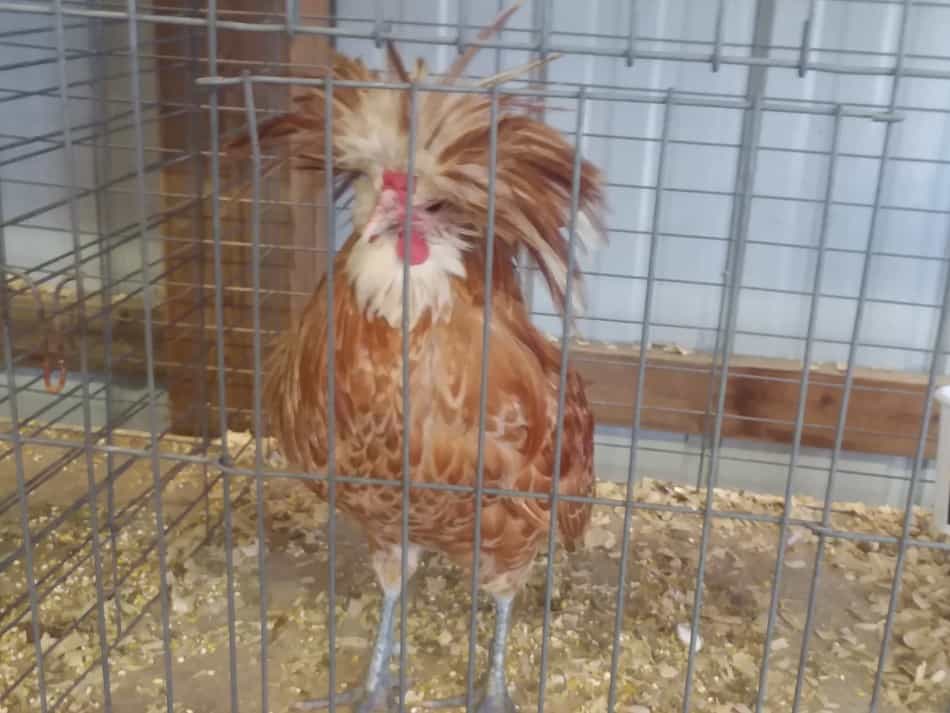
The Polish chicken actually is from the Netherlands. They are also called Dutch Crested.
Polish are one of the smaller breeds on this list and one of the more interesting breeds.
Polish chicks have a crest knob on their head-this is where the crest feathers grow from. The crest knob makes the chicks look like they each have a cotton ball stuck to the top of their heads!
As the chicks grow up the crest feathers get longer until the chicken can no longer see to the front (but can still see to the side and down).
We had a flock of the white crested black variety a few years ago. They are fun chickens to watch and relatively easy to catch.
We let them run around loose but we live back a longer drive. You will have to check on them because occasionally one will wander off and need brought back to the rest-she’s not trying to leave she’s “lost”.
Polish hens lay 2-3 small to medium sized white eggs per week. These gals are friendly and rarely get broody, but it can happen. We had one hen hatch out chicks, but just one.
Polish chickens come in three types of colors: same color for both body and crest, white crest and contrasting colored body and black crested with a white body.
Colors include black, white, blue laced, yellow white laced, cuckoo and black mottled just to give you an idea of the choices.
Sultans are a small, white rare breed
- small chicken known for making great pets
- wonderful for urban backyards
- listed as “critical” on The Livestock Conservancy rare breeds list
The Sultan is the smallest chicken listed here making it perfect for people wanting a friendly, calm chicken that will be happy in a smaller yard or in town.
Sultans are white, small rare breed of chickens with feathers everywhere! They are called Sultans because the sultan of Constantinople (now Turkey) kept these chickens in the castle gardens.
They have feathered legs, a crest and a beard, not to mention a fifth toe and blue skin on the legs.
Sultans produce 2-3 small to medium sized light brown eggs per week. Hens are non broody.
Sultans are a rare breed on The Livestock Conservancy’s list of endangered chicken breeds. This means that the U.S. population of this breed is very low.
You can help increase the numbers of this wonderful breed! If you’re looking for a calm, friendly urban yard sized chicken consider getting a few Sultans.
Chicken breeds have specific characteristics
Chickens like any other living thing vary widely in looks, ability, and temperament.
The picture at the beginning of the article shows my Salmon Faverolles that I picked specifically for being calm and friendly, and they are!
Some breeds were selected for color or other physical characteristics like size, style of comb, or specific feather pattern coloring.
Other chicken breeds were selected for one main characteristic like egg production, super fast growth, or having lots of muscle mass compared to other chickens.
Location affects chickens traits selected for
Additionally, the geography and economic particulars of the area where the breed originated plays a big role in selecting the chicken breed characteristics.
In an area of the world where the chickens are expected to fend for themselves a more agile and scrappy style of chicken will be the one to reproduce and populate the area.
A bigger bodied bird will have to find more food each day and probably not be as good as evading predators as a smaller faster chicken.
In areas where the chickens are kept more as a hobby or a fun way to provide a eggs for the family then birds can be selected for reasons that would actually be a hazard if the chickens did not have a person caring for them.
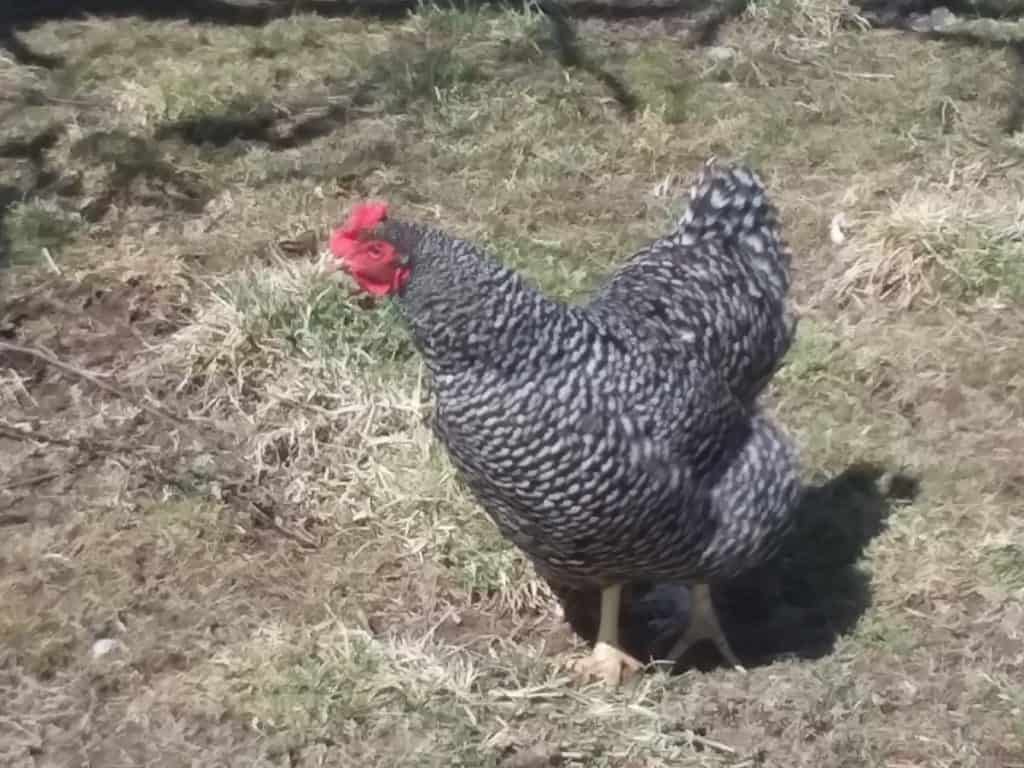
Birds of tremendous size, birds that don’t hatch or can’t hatch their own eggs, or simply birds that are pretty and a family favorite are all examples of reasons to keep or develop a line of chickens that is not as self sufficient but easier or more enjoyable for the owner.
This article outlines a variety of chicken breeds known for being more people friendly. The trade off here is that generally speaking these breeds do not have super high egg production or crazy fast growth.
If you are wanting the most eggs from your hens for your feed money go with a hybrid specialist egg production breed like the Golden Comet.
If you want the most meat the quickest, think about choosing broilers instead.
If you want a more easy going chicken that will give you plenty of eggs for your family and have a more friendly demeanor then consider one of the 20 calm chicken breeds listed.
You will frequently see the term broody used to in the descriptions. Broody just means a hen that is likely to sit on eggs to try and hatch her own chicks.
If you are not finding a chicken breed that grabs your attention try my article 12 Crested Chicken Breeds. They are not all as calm as the birds on this list but they definitely have a great look!
Resources: The Livestock Conservancy website-these folks list endangered breeds of livestock and poultry-go check them out
The Complete Encyclopedia of Chickens by Esther Verhoef and Aad Rijs; and Meyer Hatchery Catalog, Meyer Hatchery Polk, Ohio
Related Questions
Do chickens lay blue or green eggs?
Multiple chicken breeds lay blue or green eggs. The most common chicken to get if you want colored eggs is the Araucana, famed for laying eggs in many shades of blue, green and other colors.
Do chickens lay eggs everyday?
The number of eggs a chicken lays per year will depend upon how well she is taken care of and her breed. All chickens stop laying eggs at about 18 months of age in order to molt (shed her old feathers and grow new feathers). After her new feathers are grown in hens will start laying again.
